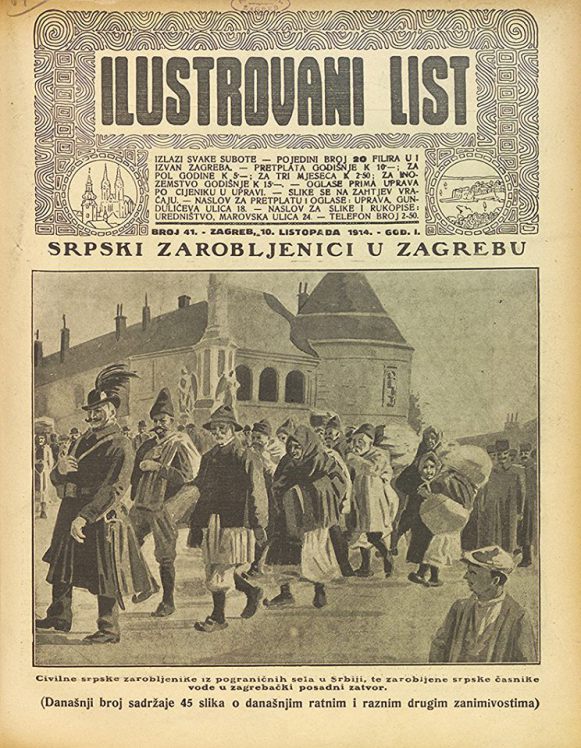 "Illustrated Sheet" was a Croatian illustrated newspaper published during the First World War, reporting on war-related events and publishing photo reports. The newspaper was issued on Saturdays from January 1914 until December 1918, when it changed its name to "Osvit". In issue number 41, dated October 10, 1914, Illustrated Sheet featured on the front page a picture of Serbian prisoners in Zagreb, and inside, a story about them, which we present here in full.
"Illustrated Sheet" was a Croatian illustrated newspaper published during the First World War, reporting on war-related events and publishing photo reports. The newspaper was issued on Saturdays from January 1914 until December 1918, when it changed its name to "Osvit". In issue number 41, dated October 10, 1914, Illustrated Sheet featured on the front page a picture of Serbian prisoners in Zagreb, and inside, a story about them, which we present here in full.
SERBIAN PRISONERS IN ZAGREB
Increasingly, groups of captured Serbian wretches are seen in Zagreb, driven under bayonet to their destinations — naturally, to prison. These are mostly women, elderly people, and children, driven from the border so they won’t hinder the army in its operations. Such transports can number up to 50 heads.
It is understood that in Zagreb, every such prisoner, especially if wearing loose trousers and a sheepskin hat, is considered a komita (rebel), and the public is greatly disappointed by the appearance of these so-called komitas. These people look so miserable that they evoke sympathy rather than anger.
It should be known that real Serbian komitas, caught in the act, are executed on the spot by shooting; therefore, everyone who can escape flees from the army, and those who remain are sent to a secure place.
(Photo: Civil Serbian prisoners from border villages in Serbia and captured Serbian officers being led to the Zagreb garrison prison)
Naturally, among the curious crowd lining the streets as these transports pass by, various remarks are heard:
"Those are the damn Vlachs!" shouts a citizen. "They should be hanged!"
"Oh, hang them? They look more like poor wretches, like robbers," interrupts a woman from Šestica.
The prisoners, however, march silently, heads bowed, carrying on their backs the little belongings left after the fire. All of them walk heavily and worriedly behind the guards, their faces showing fear and anxiety before the unknown. Surely they hope for the best, although if they are innocent, nothing should happen to them.
Among such a group were seven Serbian officers. They were all tall and handsome men. It was clear they were struggling with captivity, those used to ruling and commanding. Their heads were bowed, but their faces were open and defiant.
God knows what goes on in the souls of those men, captured by those they hated most. They marched at the rear, behind the civilian prisoners. They did not arouse pity, for in their stern military faces and uniforms there was nothing pitiable that could evoke compassion.
Naturally, many women, who had sons at the front, loudly cursed and scolded the prisoners, probably convinced that these were exactly the ones who had wounded their sons with shrapnel.
Prepared by: Sanja Bajić
Source: ЦАРСА
https://jadovno.com/srpski-zarobljenici-u-zagrebu-1914-2/?lng=cir




